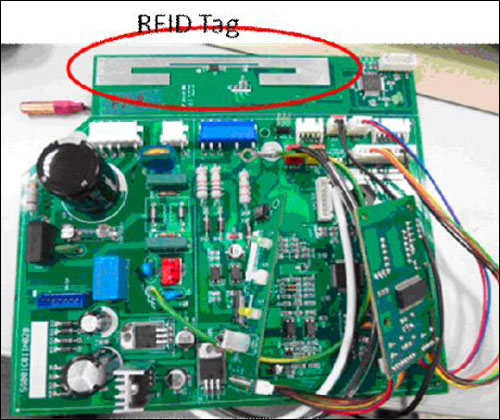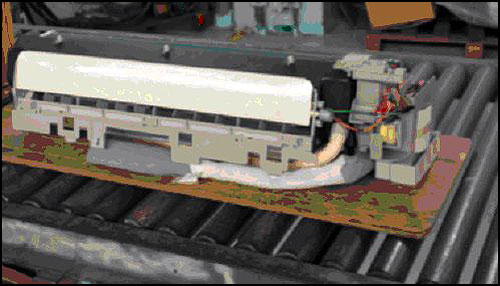TECO Group’s home appliances division has begun incorporating passive ultrahigh-frequency (UHF) RFID tags into air-conditioners manufactured at its site in Taiwan. The launch this year follows a two-year pilot that involved the tracking of 600 tagged air conditioners through assembly, distribution and consumer purchase. Tags will now be integrated in all of the 200,000 air conditioner units the firm manufactures annually. The technology enables TECO to track the assembly process of each unit from one station to the next, providing supply chain visibility through the distribution center and to store, by collecting data related to every unit’s operation once it is purchased.
For customers, the built-in EPC Gen 2 RFID tags, created specifically for this application, act as proof that the appliances they buy are authentic TECO products. Each tag also serves as a “black box,” storing what has happened to the air conditioner to which it is attached, in the event that the unit malfunctions, as well as sharing error code information with maintenance personnel. Technicians can then access the tag’s data via an EPC UHF RFID reader, in order to identify what is wrong with the air conditioner prior to its disassembly.

The solution was provided by EPC Solutions Taiwan, with consulting help from the Industrial Technology Research Institute (ITRI), a Taiwanese nonprofit research and development association. ITRI helped to develop and design the embedded tag’s antenna, as well as software for collecting and storing carbon footprint data regarding an air conditioner’s operation, according to Oscar Fang, ITRI’s service system center manager.
“The first step was to implant the RFID tag inside the air conditioner,” says T.H. Liu, EPC Solutions’ president. Since an RFID label could be easily damaged during an air conditioner’s manufacture, EPC Solutions Taiwan worked with TECO to develop a tag with a printed circuit board antenna that could be incorporated into the air conditioner’s control board. The resulting tag, made with an EM Microelectronic EM4325 chip, would then be able to communicate with the air conditioner’s own micro-controller via a Serial Peripheral Interface (SPI).
At the TECO factory, six Alien Technology ALR-9900+ fixed readers were installed at the various stations where the air conditioners are assembled or inspected. On the production line, the tag is first encoded and linked to the air conditioner in which it embedded. At each assembly station, the tag is read and its unique ID number is transmitted to EPC Solutions software residing on TECO’s database. The software combines the tag’s ID number with the assembly station’s ID, as well as a date and time stamp, and then forwards that data to TECO’s own management software, says Thomas Hung, TECO’s research and development senior manager.
At the inspection station, a quality-control officer has an ID card with its own EPC Gen 2 passive RFID tag encoded with a unique serial number. After the officer has completed a quality check of a finished air conditioner, he or she scans the card’s tag ID, and the software then directs the reader to write that officer’s ID number onto the unit’s tag, thereby creating a permanent record that is stored both in the tag’s 4,096 bits of memory, and in the software. The tag is then periodically read for the purpose of inventory tracking, before the air conditioner is packed in a cardboard box, and again at the time of packing.
The company also has another ALR-9900+ reader installed at the warehouse’s loading dock, where each air conditioner’s tag is read as the unit is shipped out. TECO’s workers use Alien ALH-9000 handheld readers when they must perform inventory checks within the facility or in stores.

When an air conditioner is sold to a customer at a retail store, Liu says, the sales staff can use an ALH-9000 handheld to read the unique ID number encoded to its tag, which serves as authentication that the unit is genuine. If an air conditioner were counterfeit, Liu explains, no tag read would take place.
At that point in time, the only data stored on the tag is the quality-control officer’s ID number, along with the date of that audit. However, once the air conditioner is put into operation at the purchaser’s home or business, the tag begins recording additional information related to the unit’s operations, such as carbon footprint data indicating how efficiently the machine is operating, as well as an error message if it malfunctions. In the event of an operational problem, TECO’s maintenance technicians carry a handheld reader to interrogate the tag’s error code. In that way, he or she can determine what is wrong prior to taking the machine apart. In some cases, disassembly is unnecessary for repair, and the tag read thus saves that maintenance worker a considerable amount of time.
According to Hung, the technology makes TECO’s products the first air-conditioners on the market to utilize RFID to provide product authentication and an error message black box. The solution is expected to save TECO money by ensuring that inventory is accurate and assembly is completed properly, as well as provide assurance to customers—who have access to an RFID reader, such as from a store or maintenance worker—that the product they purchase is authentic.

